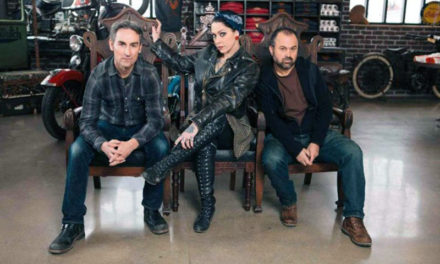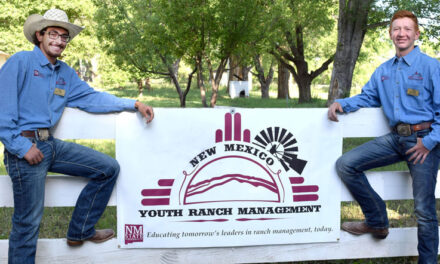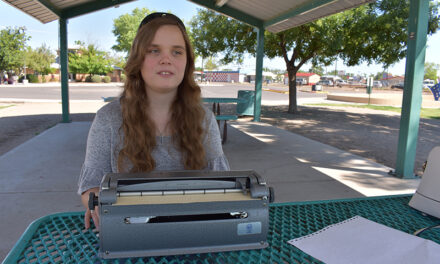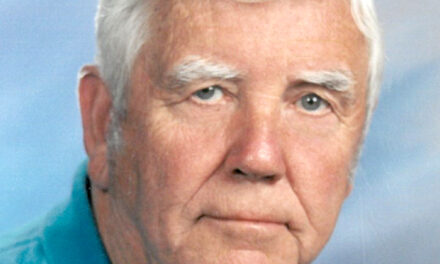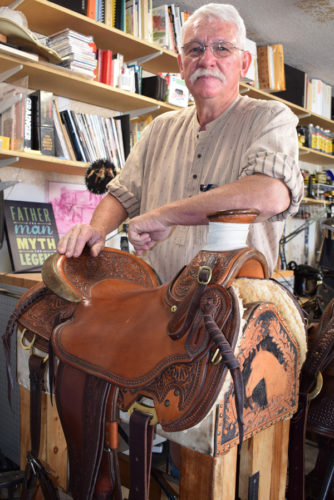
Clara Garcia | News-Bulletin photo
Tom Schatzinger, owner of Schatzinger Saddlery in El Cerro, has been making custom, handmade saddles for more than three decades. His award-winning saddles are one-of-a-kind works of art.
EL CERRO—Tom Schatzinger never intended to be a saddle maker, but luckily for many, his eye for detail, his intricate skill set and his passion for history has done him quite well.
While sitting in his shop — Schatzinger Saddlery — the aroma of worked leather permeates his garage at the home he shares with his wife, Gloria, in El Cerro. Neatly arranged are custom-made saddles, leather, tools, machinery and a multitude of history books that line the walls.
The native New Mexican has been involved in the cowboy-way-of-life for as long as he can remember. As a youngster, Schatzinger worked on several ranches and had to take care of his own saddlery repairs.
“It’s just something I became interested in,” said Schatzinger, who is retired from both the mounted patrol unit with the Albuquerque Police Department and U.S. Department of Energy. “I had made a mountain man saddle before and had done saddlery repairs and replacement parts; I had a familiarity but I had not made a full western saddle before.”
It was in the mid ’80s when a friend told him he was going to buy a saddle for $1,800 from a company that was going out of business when Schatzinger had an idea that would change his future.
“I told him if he was willing to take a chance on me, I would buy the material for two saddles — I would make him one and make one for myself,” Schatzinger said.
After building the saddle for his friend, and then one for himself, the novice saddle maker thought his was too pretty to actually use.
“I didn’t want to mess it up,” he said. “Someone told me I should put it in the county fair, and I won first place. A guy there told me I needed to put it in the state fair.”
When Schatzinger took his saddle to the state fair, he was asked if it was for sale.
“If someone wanted to buy it, it’s for sale,” Schatzinger told them.
Because the saddle was available for purchase, it was automatically entered in the professional division. Needless to say, Schatzinger’s second-ever handmade saddle won first place.
Hit with the bug, Schatzinger made another saddle without much tooling, he said. He had about 10 hours of riding in it when his neighbor, who he had been buying hay from, went to his house with his two brothers.
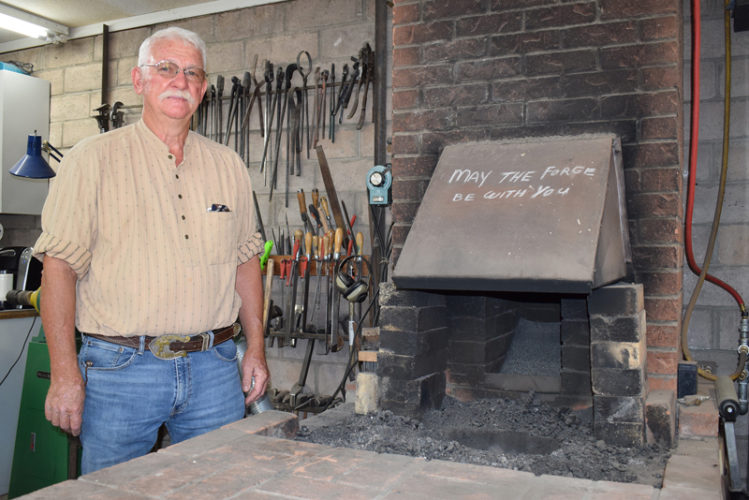
Clara Garcia | News-Bulletin photo Tom Schatzinger has been a blacksmith longer than he’s been making custom saddles. He has forged most of the tools he uses in his blacksmith shop behind his home in El Cerro.
The neighbor saw the saddle that had won first-place in the state fair and asked how much he wanted for it. Schatzinger gave him a price and his neighbor gave him a check.
As he was re-oiling his newest-made saddle, one of the brothers asked Schatzinger how much he was willing to sell it for.
“I said it was mine, and he said, ‘Yeah, what do you want for it?’ I gave him a price and he asked me to make him a matching breast collar and bridle,” he remembers. “He wrote me a check and said he’d pick it up the next week.”
The third brother told Schatzinger he wanted a plain saddle with nothing but his initials on the back of the cantle.
“I had made two sales and one order on the same day, so I thought I must be a saddle maker,” Schatzinger said. “At one point, my saddles were getting pretty popular and people were asking for the accessories and repairs.”
While still working with the DOE, Schatzinger thought about opening up his own shop at a storefront in Los Lunas. But after calculating what it would cost, he realized he would have to make and sell a custom saddle every month just to pay his rent and utilities.
“When you figure that … depending on the construction, it could take between 40 to 60 hours to build a saddle,” he said. “One saddle I did took about 120 hours of tooling because it’s all done with a mallet and small hand tools. It’s quite a process — a lot of detailed work.”
While a lot of professional saddle-making companies have hydraulic presses that can press the design into the leather, Schatzinger does it all by hand — including the cutting and carving the leather, the stitching, the cantle binding, shaping the seat and all the other steps it takes to make a saddle.
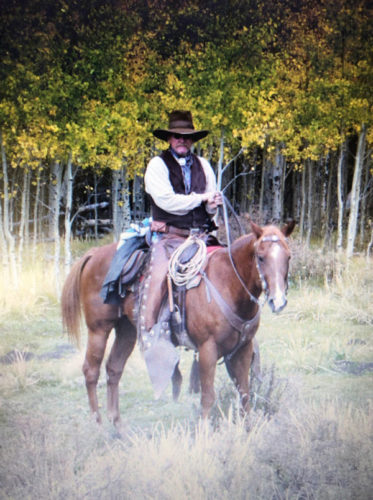
Submitted photo
Tom Schatzinger has been riding for as long as he can remember. He says having a custom saddle makes all the difference, whether it’s for riding in the mountains or in a rodeo.
“These last a very long time,” he said of his saddles. “You’re hand-carving that leather to smooth it out so you don’t have pressure spots on your legs. They’re carved to the shape of a person.
“I used to ride padded seats until I learned how to make a saddle. The first saddle I made was not a padded seat but a carved seat and it was comfortable.”
Schatzinger explain that each custom saddle is made for each individual rider, saying he measures the customer to make sure the seat is the right fit. What matters, he said, is the distance from the back of the pommel — the front of the saddle — to the cantle — the back of the saddle.
When riding in the mountains, Schatzinger likes a 16-inch seat, but when he was doing cowboy mounted shooting, he prefers a 15 1/2 inch seat, explaining when someone is doing fast turns, the rider’s hands are occupied, and with a closer seat, they are not going to move around a lot. A half inch makes a lot of difference, he said.
The size of a saddle depends on what type of riding they are doing, he said.
“If you’re calf-roping, you want a saddle that you can get out of quickly, a low pommel, a low seat, wider stirrups,” Schatzinger said. “If you’re riding rough stock, you want a narrower stirrup so it doesn’t flip off of your foot.”
When Schatzinger started getting orders for more saddles, his customers wanted more customized accessories, such as engraved silver conchos. He would have to find a jobber who was having to find a maker, and he was losing money or just breaking even on the silver.
Instead, Schatzinger decided to go to engraving school, and started making his own silver, which then led him to making custom knives.
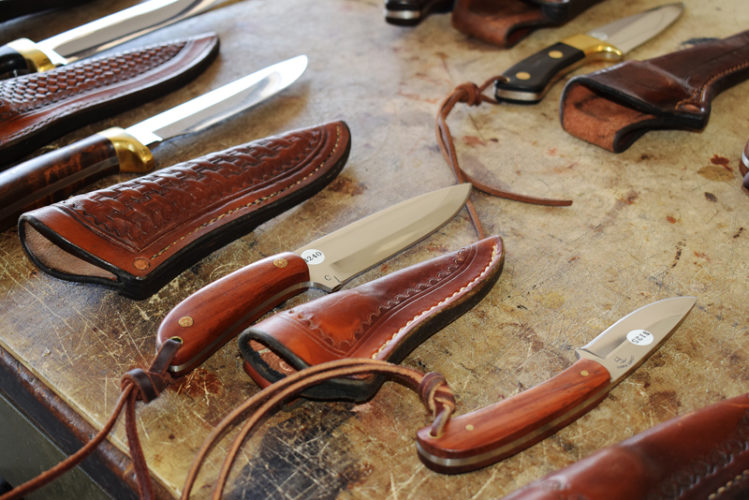
Clara Garcia | News-Bulletin photo
Along with making custom saddles, Tom Schatzinger has been forging knives for decades. His precision craftsmanship can also be seen in the leather sheaths he makes.
“I liked engraving so much, I made a replacement blade with my brand on it,” he said. “That was something that went along with knife making.”
Even before he was a saddle maker, Schatzinger was involved in a mountain man organization, and they would participate in competitions wearing period dress. In between the muzzle-loading rifle and shooting competitions, they’d do tomahawk and knife throwing. That’s when he got into doing blacksmithing.
“I made a knife out of a horseshoing rasp, and it looked pretty cool,” he said. “It was something back in the day when you didn’t throw away a good piece of steal, you just made it into something else. This is where it started at.”
Just like his saddles, someone saw the knife and asked where he got it. When he told him he had made it, they asked how much he’d charge him for one.
“I can forge the knives and put a nice finish on them, or I can grind the knives,” he said. “There’s a lot of choices of what the buyer wants.”
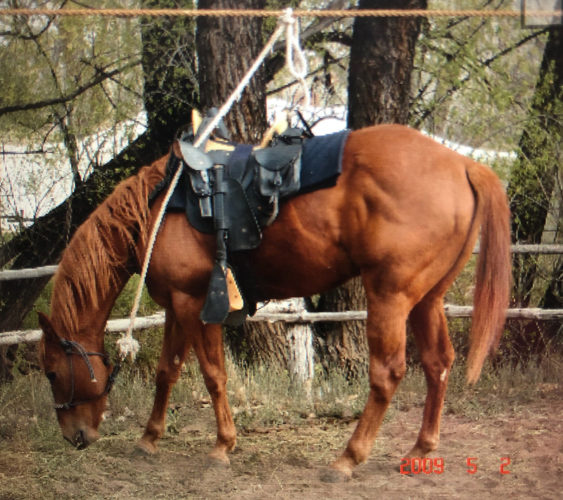
Submitted photo
Tom Schatzinger’s passion for history can be seen in the saddles he makes, including this one, a replica of a calvary saddle from the Civil War era. Schatzinger says he made the saddle to the specifications of the Army Ordinance Manual, including making the black dye from iron filings and vinegar for the leather.
Schatzinger’s wife, Gloria, said it’s taken years for him to develop his skills — hours and hours of work — as a silversmith, a saddle maker, a knife maker and as a blacksmith.
“He’s very authentic, very accurate and very precise,” Gloria said. “If he isn’t sure, he goes back to his history books and will research. It’s frustrating when you’re watching a Western on TV and he’ll say something isn’t accurate.”
While Gloria is very proud of her husband’s creativity and talent, he is a bit more humble.
“Some people tell me I’m so talented, but I just say I’m persistent,” Schatzinger said. “Nobody has seen my scrap pile. There have been times when I mess up on a saddle and end up having to use the leather on something else. I want to be right.”
Schatzinger said his saddle-making days have slowed down over the past few years, explaining it’s become more difficult to find quality leather because the federal government has shut down all but two saddle leather producers in the U.S. Now, he says, the price of leather has more than doubled.
Clara Garcia is the editor and publisher of the Valencia County News-Bulletin.
She is a native of the city of Belen, beginning her journalism career at the News-Bulletin in 1998 as the crime and courts reporter. During her time at the paper, Clara has won numerous awards for her writing, photography and typography and design both from the National Newspaper Association and the New Mexico Press Association.

